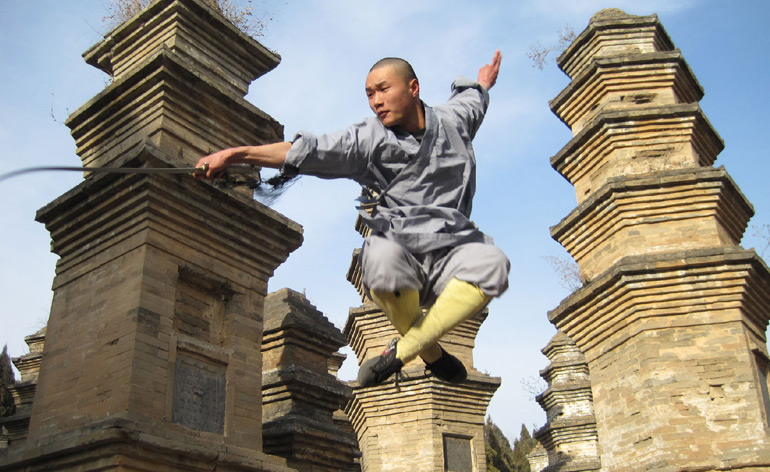
Those kind folks from the Shaolin Show want to share some bonus footage with Kung Fu Kingdom fans of the monks practicing their skills at the famous Pagoda Forest!
The forest stands at the foot of Shaoshi Mountain about half a kilometre west of the Shaolin Temple in Henan Province, and is composed of 250 or so pagodas dating from 791 to 1803. The pagodas are mostly tombs for eminent monks, abbots and ranking monks at the temple. They all carry the exact year of their construction and many carvings, inscriptions and calligraphy from various dynasties.
Although most of them are ancient, some of them are comparatively modern, one of them even showing a motorcar among its decorations. There is also some evidence of the activities of some eminent foreign monks. In the eastern part of the forest a tomb pagoda built in 1339 in the Yuan Dynasty bears an epitaph written by a Japanese monk at Shaolin Temple. In the western part of the forest is a tomb pagoda built in 1564 in the Ming Dynasty for an Indian monk.
Both the Shaolin Monastery and the Pagoda Forest were classified as a UNESCO World Heritage Site in 2010 and have become a popular tourist attraction. The pagodas have been used as a dramatic backdrop in classic kung fu films such as Jet Li’s “The Shaolin Temple” and Andy Lau’s “Shaolin”, and of course for the performances of the present day Shaolin students.
This clip features two of the younger monks practicing their Shaolin longfist techniques. Dulian (duelling) forms are a good way to practice some of the self defence applications of the standalone forms. They can also look pretty cool as choreographed fighting sets too!
This one starts acrobatically enough before piercing the air with the Shuang Jiu Jie Bian (double nine section whip chains). Using one of these weapons without seriously injuring yourself is hard enough, let alone two of them! The chain whip is used as a whip to hit, hook and bind an opponent, restrict their movement, and to deflect blows from other weapons. The dart is used for slashing or piercing an opponent. Because the whip is flexible, it can be used to strike around obstacles, including an opponent’s block.
The final clip is a duelling set using the Dao, or Chinese sabre. Known as “The General or Marshal of all Weapons”, the Chinese sabre or broadsword is probably the most commonly taught of all the wushu weapons. Sharpened on one edge, with a slightly curved blade, the broadsword has a few variations. Broadswords can be long or short, used individually (Dan Dao) or in pairs (Shuang Dao), or have steel rings through the blade to entangle spears. Swords can be Northern (Beidao) or Southern (Nandao) in style. The most common form of Chinese broadsword was the Liuye Dao, or “willow leaf sabre”.
Being the standard sidearm for both cavalry and infantry, the Liuye Dao became the basis for the weapon used by many schools of Chinese martial arts. Traditional swords had a solid blade forged from bronze, iron or steel. Modern wushu swords have a flexible sprung steel blade, with anywhere between 30% and 70% of the blade being flexible. The flexing of the sword allows the wushu performer to demonstrate the power of their cuts and thrusts.
Usually a silk cloth is attached to the hilt, traditionally used to clean an opponent’s blood from the handle so as not to impede grip. Being a single-edged weapon, it tends to be used as slashing rather than a stabbing weapon. Two-person fighting sets are a good way for a student to learn the characteristics of their weapon as well as how to judge distance and co-ordination with their partner.
If you have enjoyed these clips check out our full review and article on the latest Shaolin performance here and you can see these high energy skills and many, many more on the new Shaolin Show DVD – available to buy here: http://amzn.to/1lM37up






